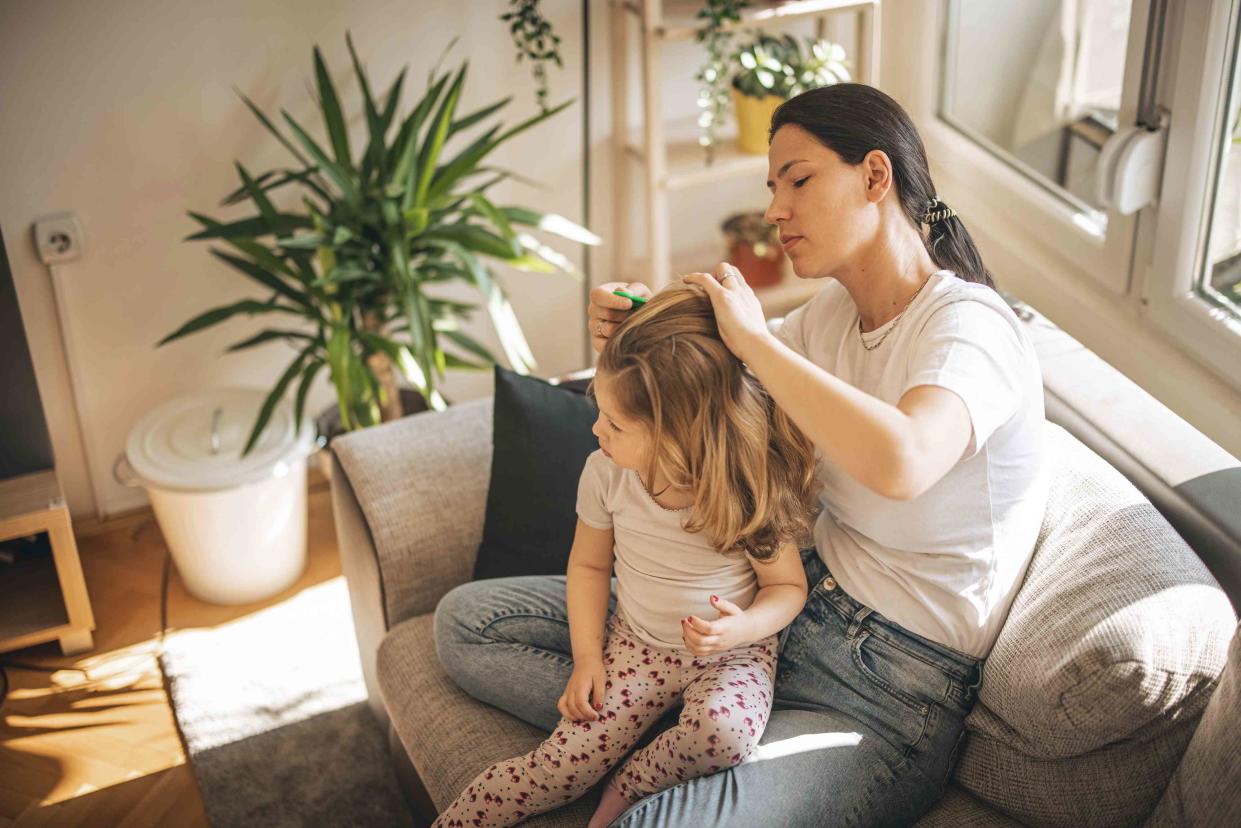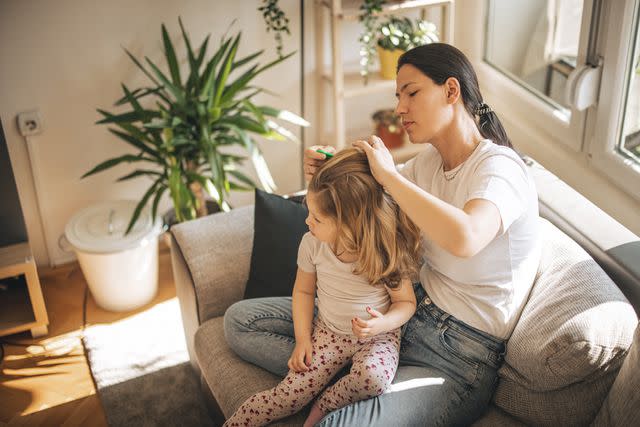What Are Head Lice?

freemixer / Getty Images
Medically reviewed by Isabel Casimiro, MD PhD
Head lice (Pediculus humanus capitis) are wingless insects that feed off human blood on the scalp. They are commonly found in school-age children, although anyone can contract them.
The most prominent symptom of head lice is an extremely itchy scalp. Itching occurs as an allergic reaction to the louse bites.
This article explains how head lice form, their symptoms, treatment, and prevention.

freemixer / Getty Images
The Life Cycle of Lice
Head lice are insects that live on the surface of a host. Humans are the only host for head lice. They go through three distinct phases in their life cycle.
Adult lice lay nits (eggs) on hair shafts (where the hair projects from the scalp) and stick to the scalp. On first appearance, lice and dandruff flakes can be mistaken for one another because of their common size and yellowish-white color.
Nits generally hatch in one week.
Nymphs are newly hatched lice. They are about the size of a pinhead and will be fully grown adults after about one week.
Adult lice are about the size of a sesame seed and are tan to grayish-white. Depending on your hair color, they can be challenging to see. Adults can lay up to eight nits daily and live up to a month on your scalp. Without a blood meal several times daily, an adult louse will die within a few days.
Between 6 million and 12 million lice infestations occur annually in school-age children in the United States. Head lice are contagious, spreading via head-to-head contact and can pass among children during play. Less commonly, they are spread through shared objects like hats, brushes, and pillows.
Read Next:Causes and Risk Factors of Head Lice
Signs of Lice Eggs in Hair
If you suspect a family member has lice, check their head by doing the following:
Wear disposable gloves.
Use your fingers to create a part in the hair to see the scalp.
Look for nits on the hair shaft about one-quarter inch from the scalp.
Check the edges of the hairline, like the ears, forehead, and neck.
Louse nits can be easier to detect than lice, possibly because they cannot move or hide. When looking for nits, look closely at the scalp, where they tend to stick after lice lay them. Check the crown of the head, around the bangs, ears, and neck.
Head Lice Symptoms: Beyond Itching
While itching is the most well-known and common head lice symptom, other signs can indicate you or your child has lice. These include:
Scratching
A crawling sensation
Seeing bugs or eggs in the hair
You can have head lice and not have an itchy head. It can sometimes take a few weeks after having lice for the itching to start.
Swollen lymph nodes can occur due to the excessive scratching injuring your skin, which leads to open sores and a bacterial skin infection. This causes the lymph nodes to take action to fight the infection. Excessive scratching of the eyes can cause you to develop pink eye (conjunctivitis).
Head Lice Treatment
Combing out the lice is the essential step of any head lice treatment. A special lice comb with narrow teeth can help you remove nits and lice.
However, combing isn't effective on its own. You'll need to comb after you've applied treatment. To comb out lice, follow these steps:
Wet the hair.
Comb through the hair in sections with the nit comb.
Then wipe the comb on a wet paper towel.
Repeat until you are through the entire head.
To kill any lingering nits and lice, wash clothing, bedding, hats, and towels in hot water on high heat.
Home Remedies
Natural remedies for head lice involve applying oil, such as olive oil or mayonnaise, or petroleum jelly, to the hair to suffocate the lice. Most people who choose this method saturate the hair and scalp and cover it with a shower cap overnight. Then, they shampoo and comb out the lice and nits in the morning.
While some people say these methods work, no evidence supports the claim.
OTC Medications
Many over-the-counter (OTC) lice treatments are available at drugstores. These do not require a prescription, but you should use care since they are pesticides, meaning they kill bugs. These medicated shampoos usually include pyrethrins or permethrin as active ingredients.
Follow these tips when using these medications:
Read and follow package directions carefully.
Do not apply or rinse off the solution in the shower; apply when fully clothed, and rinse your head in a sink with running water.
Do not combine products.
Use only the directed amount.
Use the lice comb afterward.
Evaluate hair after eight to 12 hours.
If the medicine seems to be working, wait a few days to wash your hair, and keep combing each day for a couple of weeks to ensure you remove all of the lice. You may need to treat again in a week to kill surviving lice that hatched after the first round of treatment.
If OTC treatment isn't successful, you may need to see a dermatologist for assistance.
Prescription Medications
A healthcare provider may prescribe a stronger medication if OTC treatments don't work. These work the same as OTC medications, but read and follow your healthcare provider's instructions on proper use carefully.
The following are approved prescription medications for head lice:
Benzyl alcohol
Sklice (ivermectin)
Ovide (malathion)
Natroba (spinosad)
Lindane
More potent medications may have additional side effects and risks, like itching or burning skin and eye irritation. Some medicines are inappropriate for young children, while others are approved for infants as young as 6 months old.
Should You Stay Home With Head Lice?
Head lice are a nuisance, but, fortunately, they do not spread disease. Unlike in the past, kids could not return to school until they were free of nits; now, experts say this is unnecessary. That's because nits are not viable and are unlikely to be transferred to others, among other reasons.
Students may return to school after treatment has begun. That means you could have head lice, go home and treat it, then return the next day.
What to Do If Head Lice Keeps Coming Back
If you think you've rid yourself of head lice only to have them return a couple of weeks later, chances are you didn't get every last louse and nit. Following through with treatment, repeating combing, and re-shampooing (per directions) are critical.
Having lice does not indicate a lack of cleanliness or poor hygiene. If you have recurrent head lice, repeat the treatment, being as thorough as possible for the duration. If you're frustrated or overwhelmed, you might want to consult with a healthcare provider.
How to Prevent Head Lice
Recommendations for preventing head lice include:
Avoid head-to-head contact.
Do not share clothing, hats, combs, brushes, or hair accessories.
Disinfect combs and brushes used by an infected person.
Avoid lying on furniture that an infected person recently used.
Wash bedding, clothing, furniture, and floors if someone in your home has been infected.
Not fumigating—this is unnecessary for killing lice and can be toxic.
If someone in your household gets head lice, check all family members regularly for the next couple of weeks to be sure they haven't acquired them, too.

